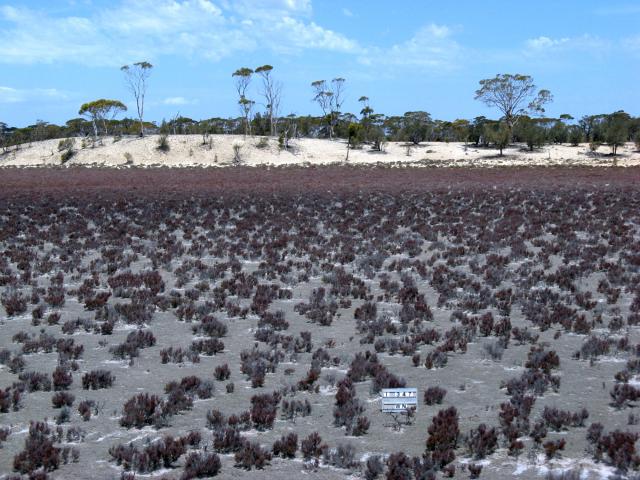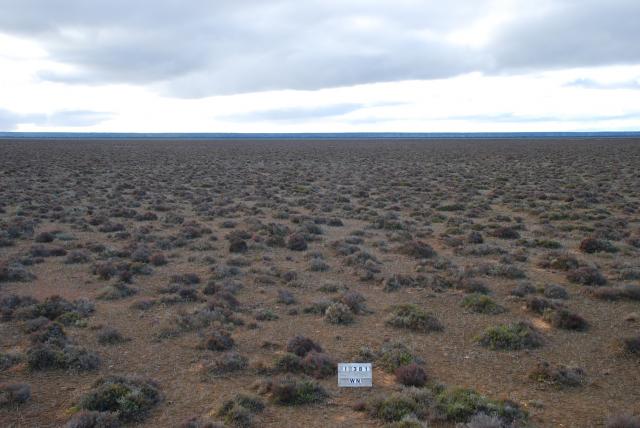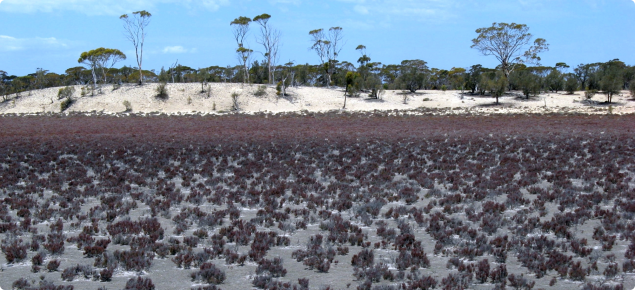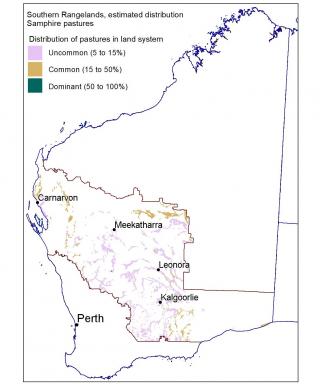Pastoral potential – very low to nil
Samphire pastures in the southern rangelands have very low pastoral value. The saline foliage is not readily grazed by stock unless water supplies are fresh and there is not much else to graze. Some of the palatable species that make up a very minor and peripheral part of samphire pastures can be grazed out. Opportunistic use may be possible when seasonal conditions lead to the growth of annual herbage or buffel grass colonises areas between the perennial shrubs.
Suggested levels of use (per annum)
Table 1 provides a rough guide to the range of pastoral values for good condition pastures, which must be checked against conditions in each region and paddock. Carrying capacities for fair condition pastures might be 75% to 50% of good, and poor condition pastures less than 50% of good.
See Introduction to pastures in the southern rangelands of Western Australia for an explanation of how carrying capacities are estimated.
| Condition | Carrying capacity ha/DSE1 | Carrying capacity ha/CU2 (ha/AE3) |
|---|---|---|
| Good | >30 | >210 (≥252) |
1 DSE is based on the feed energy required to maintain a 45 kilogram liveweight Merino wether with zero weight change, no wool growth additional to that included in maintenance, and walking 7 km/day. 1 DSE has an energy requirement of approximately 8.7 MJ ME/day.
2 CU in the southern rangelands is based on a 400 kg steer at maintenance and equivalent to 7 DSE.
3 AE is based on the feed energy to maintain a 450 kg Bos taurus steer 2.25 years of age, walking 7 kilometers each day. 1 AE has an energy requirement of approximately 73 MJ ME/day and equivalent to 8.4 DSE.
Management
The salt content, low productivity and low palatability of samphire pastures means these pastures are rarely grazed, and have no special management requirements.
Soil erosion is not usually associated with a decline in condition. Soils are generally stable due to their position in the landscape as deposition zones which are periodically inundated.
Pasture condition
The general finding of the combined surveys, derived from traverse observations, is that samphire pastures are mainly in good condition.
Good
See Figures 1, 2. Pastures are dominated by samphires, which may or may not include some palatable perennial shrubs, grasses and annual herbage. They are the most saline of the pasture types dominated by perennial chenopod shrubs, and are not normally grazed unless very close to a source of fresh water. Stock show clear preference for less saline pastures where available.
Fair and poor
The density and diversity of palatable low shrubs such as saltbushes and bluebushes will decline under heavy grazing pressure. However, as samphire pastures can be homogenous and dominated solely by one species, this is not a reliable indicator of condition as palatable species may not be present. A reduction in total plant cover may constitute vegetation degradation, but this is uncertain as other variables such as death caused by inundation may also contribute to changes in cover.
Samphire pastures condition photographs


Vegetation structure and composition
Samphire pastures are very distinctive, characteristically uniform areas of low or very low chenopod shrubland. These pastures are almost always a scattered low shrubland less than 60cm high. Projected foliar cover (PFC) generally ranges from isolated to very scattered (2–10%) in the Gascoyne and very scattered to scattered (7.5–20%) in the Murchison, though 30% can occur in some cases. A mid-shrub stratum and, less commonly, a perennial grass stratum may be present. The low shrub layer is dominant, and larger shrubs and trees are generally only present as gradations into other pasture types. These pastures may grade into saltbush, bluebush or Frankenia pastures.
Tecticornia plants (syn. Halosarcia, Sclerostegia and Pachycornia) invariably dominate samphire pastures. Other low shrubs are bladder saltbush, sage, pigface, frankenias, sweet samphire, needlebush, ball leaf bluebush, sago bush, three-winged bluebush and flannel bush. The seasonal herbage response is limited and consists of mainly annual grasses with sparse herbs (ephemeral chenopods) and daisies.
Samphire pastures appear to be very durable, though in response to episodic flooding fluctuations in population size can occur. The low species diversity highlights the harshness of these habitats and the types of conditions that only a limited number of halophytic species can tolerate, in particular salinity and waterlogging.
Occurrence
Samphire pastures occur in areas where drainage is slow and there is periodic waterlogging which results in salts accumulating in the soil profile, making these areas highly saline. They cover an estimated 0.77 million hectares (0.9% of the southern rangelands). These can be found in a variety of positions in the landscape, but most occur on the highly saline soils of lake beds and lake margins, as well as low-lying kopi deposits adjacent to salt lakes.
Samphire pastures are also common on low-lying saline alluvial plains along the rivers and major drainage systems, including some isolated claypans in flood plains and on the banks and levees of some major watercourses. Samphire pastures may also occasionally occur in sluggish drainage tracts where salts accumulate in upland environments, and in the south of the Nullarbor Plain, in some saline depressions.
Associated plants
| Common name | Scientific name (links to FloraBase) | Desirability* |
|---|---|---|
| Ball leaf bluebush | D | |
| Bladder saltbush | D | |
| Brittle bluebush | D | |
| Bronze bluebush | D | |
| Buffel grass | D | |
| Cotton bush | D | |
| Felty leaf bluebush | D | |
| Frankenias | Frankenia spp. | D |
| Old man saltbush | D | |
| Sage | D | |
| Sweet samphire | D | |
| Needlebush | U | |
| Sunglasses bush | U | |
| Three-winged bluebush | U | |
| False bluebush | I | |
| Flannel bush | I | |
| Sago bush | I | |
| Samphire | I | |
| Samphire | I | |
| Samphire | I | |
| Samphire | I | |
| Samphire | Tecticornia pergranulata | I |
| Samphire | I | |
| Samphire | I | |
| Samphires | Tecticornia spp. | I |
| Pigface | N | |
| Nullarbor Gunniopsis | N | |
| Thick leaf fanflower | N |
* D = desirable, U = undesirable, I = intermediate, N = no indicator value


